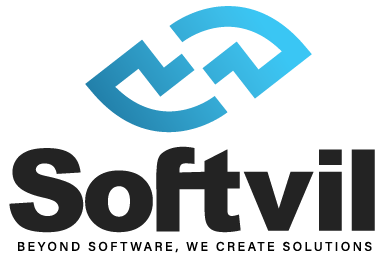In this article, we embark on an enlightening journey through the intricacies of creating a successful website, with insights from the expertise of SoftVil Technologies. From the initial planning stages to its continued success post-launch, we’ll explore the key steps and best practices that go into developing a remarkable online presence. SoftVil Technologies, as a prominent player in the industry, brings their extensive knowledge and innovative approach to the table. Learn how meticulous planning and research, coupled with their technical prowess, have empowered numerous businesses to establish a strong digital footprint. Discover the art of designing user-friendly interfaces, implementing responsive front-end development, and optimizing websites for superior performance.
Furthermore, we’ll delve into the back-end development strategies that ensure seamless functionality and enhance user experience. As we journey through content creation, SEO optimization, testing, and the art of launching a website, SoftVil Technologies’ expertise will provide invaluable insights for your web development endeavors. Join us on this enriching exploration as we equip you with the knowledge to craft a website that not only aligns with your objectives but also showcases the excellence of SoftVil Technologies in the ever-evolving realm of website development.
Planning and Research

Before embarking on the website development journey, thorough planning and research are essential to ensure the project’s success and align it with the intended goals.
Defining Website Objectives
The first step in the planning phase is to determine the primary purpose of the website. Whether it’s to provide information, facilitate e-commerce transactions, generate leads, or offer a combination of services, a clear objective sets the direction for the entire development process. Setting specific and measurable goals further allows tracking the website’s performance and effectiveness in achieving its intended objectives.
Identifying the Target Audience
Understanding the target audience is crucial for tailoring the website’s design and content to meet their specific needs and preferences. Conducting demographic research provides valuable insights into the intended users’ age, gender, location, interests, and preferences. Creating user personas representing different segments of the target audience helps developers empathize with users, designing personalized and engaging user experiences that resonate with the end-users.
Market Research and Competitor Analysis
Thorough market research is essential to identify potential opportunities and challenges in the industry landscape. Analyzing market trends allows developers to stay ahead of the curve and incorporate the latest innovations. Additionally, conducting a comprehensive analysis of competitor websites helps assess their strengths, weaknesses, and unique selling points. This insight aids in differentiating the website and crafting a compelling value proposition to attract the target audience.
Content Strategy
A well-defined content strategy plays a significant role in engaging website visitors and achieving the website’s objectives. Defining the type of content that will resonate with the target audience is crucial. Whether it’s informative articles, captivating videos, visually appealing infographics, or interactive elements, the content should align with the website’s purpose and the preferences of the target audience. Planning the content structure and information hierarchy ensures seamless navigation, making it easier for users to find the information they seek and enhancing their overall user experience.
Design and Layout

Design and layout play a crucial role in shaping the overall look and feel of the website, as well as enhancing the user experience. This phase focuses on creating a visually appealing and user-friendly interface that aligns with the website’s objectives.
Wireframes and Mockups
To begin the design process, developers create wireframes that outline the website’s layout, functionality, and user flow. Wireframes serve as a blueprint, providing a visual representation of the website’s structure and the arrangement of elements. They allow stakeholders to understand the website’s overall structure and ensure that essential features and content are appropriately placed.
Developing interactive mockups is the next step, which allows stakeholders to visualize the website’s appearance and interactions. Mockups are more detailed representations of the design, showcasing color schemes, typography, and visual elements. Gathering feedback from stakeholders at this stage is crucial as it helps in fine-tuning the design before moving on to the development phase.
Choosing the Design Approach
Selecting the right design approach is essential to create a cohesive and visually appealing website that resonates with the brand’s identity and objectives. The design style should reflect the brand’s personality and effectively communicate the website’s purpose to the target audience.
Developers have various options, including pre-designed templates, custom designs, or hiring a professional web designer. Pre-designed templates offer a cost-effective and time-efficient solution, suitable for simpler projects. Custom designs, on the other hand, allow greater creativity and flexibility to tailor the website to specific requirements. Hiring a professional web designer ensures a polished and unique design that aligns with the brand’s vision.
Front-End Development

Front-End Development is a crucial aspect of website creation, as it directly influences how users interact with the site. It involves implementing the visual elements and user interface to ensure an engaging and seamless user experience.
HTML/CSS Implementation
Front-End Developers use HTML (Hypertext Markup Language) to structure the website’s content, defining headings, paragraphs, images, and other elements. CSS (Cascading Style Sheets) comes into play to apply styling and layout to these elements, ensuring a visually appealing and consistent design.
Responsive Design
In today’s mobile-centric world, Responsive Design is essential. Front-End Developers utilize CSS media queries and flexible layouts to ensure that the website adapts flawlessly to various devices and screen sizes, providing a user-friendly experience on desktops, tablets, and smartphones.
Multimedia Integration
Adding multimedia elements such as images, videos, and interactive components enhances user engagement and visual appeal. Well-placed visuals and interactive features encourage users to explore the website further, resulting in longer visit durations.
Optimizing Performance
Front-End Developers optimize multimedia files to reduce loading times, ensuring a smoother and more enjoyable browsing experience. Efficient code and optimized assets contribute to faster page loads and overall better website performance.
Back-End Development

While Front-End Development focuses on the visual presentation and user experience, Back-End Development is the backbone that ensures a website’s functionality runs smoothly and securely. SoftVil Technologies, with their expertise in this domain, excels in delivering robust and efficient Back-End solutions.
Choosing Back-End Technology
One of the critical decisions in Back-End Development is selecting the appropriate programming language and framework. Meticulous evaluation of project requirements and scalability needs determines the ideal technology stack. Consideration is given to factors like security, database integration, and server performance, ensuring the chosen technology aligns perfectly with the project’s goals.
Server-Side Functionality
Back-End Developers are adept at developing a wide range of server-side features. This includes user authentication to safeguard user data, secure data storage, and seamless form processing. Backend logic is intricately crafted to ensure the website’s dynamic functionality meets user expectations.
Implementing Security Measures
Security is paramount in Back-End Development, and stringent measures are implemented to protect sensitive user data, thwart potential vulnerabilities, and ensure a secure user experience.
Content Creation and SEO

In the digital landscape, content creation and SEO go hand in hand, playing pivotal roles in driving website success. Employing a strategic approach, experts in this domain create compelling content that not only captivates users but also boosts search engine visibility.
High-Quality Content
Recognizing the significance of high-quality content, experts produce valuable and engaging material that aligns with the website’s objectives and caters to the needs of the target audience. Through adept storytelling, powerful calls-to-action, and compelling visuals, they ensure that visitors stay captivated and motivated to explore further.
SEO Optimization
To improve online visibility and reach the target audience effectively, experts perform extensive SEO optimization. Conducting thorough keyword research helps identify relevant search terms that align with the website’s content. By incorporating these keywords naturally into the material, they ensure that the website ranks higher on search engine result pages, leading to increased organic traffic.
Additionally, experts optimize meta tags, headings, and image alt attributes to further enhance search engine visibility. These optimization techniques provide search engines with relevant information about the website’s content, enabling better indexing and improved search rankings.
Testing and Launch

Before a website goes live, rigorous testing is essential to ensure its functionality and user experience meet the highest standards. SoftVil Technologies employs a comprehensive testing and launch process to deliver a seamless and successful website release.
Quality Assurance
Thorough quality assurance testing is conducted to identify and rectify any bugs, errors, or broken links. This meticulous examination guarantees a smooth and error-free website experience for visitors. Additionally, the team tests the website’s compatibility across various browsers and devices, ensuring consistent functionality and appearance regardless of the user’s preferred platform.
User Testing
Gathering feedback from real users is a vital aspect of the testing phase. Target audience members’ input is sought to assess the website’s usability and identify areas for improvement. User feedback serves as a valuable tool to understand how visitors interact with the website, allowing for necessary adjustments to enhance the user experience further.
Website Launch
Upon successful testing, the website is deployed to the chosen hosting server, making it accessible to the public. The launch marks a moment of culmination, where the website becomes available to its intended audience. Post-launch, the team closely monitors the website’s performance, promptly addressing any issues that may arise. Regular monitoring ensures that the website continues to function optimally and delivers a delightful user experience.
Maintenance and Updates

A successful website is not just a one-time effort but an ongoing journey of maintenance and updates to keep it relevant, secure, and high-performing. SoftVil Technologies takes the reins in this crucial phase, ensuring websites remain dynamic and user-friendly.
Regular Content Updates
To keep users engaged and informed, SoftVil Technologies emphasizes the importance of regular content updates. They diligently refresh the website’s content, providing visitors with fresh and up-to-date information. This approach not only establishes the website as a credible source but also encourages repeat visits from satisfied users. Implementing a content calendar helps in organizing and scheduling regular updates and additions, ensuring consistency in delivering valuable content to the audience.
Security and Performance Monitoring
Prioritizing website security, continuous monitoring for potential vulnerabilities is essential. Performing thorough checks to identify any security loopholes and promptly implementing necessary security patches ensures user data is safeguarded, establishing trust with visitors.
Moreover, keeping a close eye on website performance is critical. Continuous monitoring for potential bottlenecks ensures that the website performs optimally, providing a seamless user experience. Swift optimization measures are taken whenever needed to maintain fast loading times and smooth navigation.
Conclusion
In conclusion, website development is a multifaceted process that requires careful planning, thoughtful design, meticulous testing, and continuous maintenance. SoftVil Technologies‘ expertise in the various stages of web development ensures a seamless and successful journey from conception to launch and beyond. By focusing on user-centric design, incorporating the latest technologies, and prioritizing SEO optimization, they create websites that not only impress visually but also deliver a superior user experience. Furthermore, their commitment to ongoing maintenance and updates ensures that websites remain relevant, secure, and high-performing in the ever-changing digital landscape. With SoftVil Technologies at the helm, businesses can confidently embrace the online realm and establish a strong and impactful online presence.

